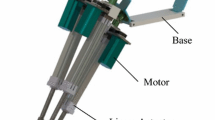Abstract
In this paper, first the application of homotopy continuation method (HCM) in numerically solving kinematics problem of spatial parallel manipulators is investigated. Using the HCM the forward kinematics problem (F-Kin) of a six degrees of freedom (DOFs) 6–3 Stewart platform and the inverse kinematics problem (I-Kin) of a 3-DOF 3-PSP robot are solved. The governing equations of the kinematics problems of the robots are developed and embedded in the homotopy continuation function. The HCM is utilized in order to solve the nonlinear system of equations derived from the kinematics analysis of the robots. Then, to represent the real case application an initial guess far from the correct answer is selected. It is shown that, comparing with the Newton–Raphson method (NRM), the F-Kin calculation time for the Stewart robot is decreased by 43%. Therefore, using the HCM a hybrid method is suggested to solve the F-Kin of the Stewart robot. Furthermore, the HCM, as an innovative method, relieves other downsides of the conventional numerical methods, including a proper initial guess requirement as well as the problems of convergence.








Similar content being viewed by others
Explore related subjects
Discover the latest articles, news and stories from top researchers in related subjects.References
Rezaei A, Akbarzadeh A, Akbarzadeh-T M-R (2012) An investigation on stiffness of a 3-PSP spatial parallel mechanism with flexible moving platform using invariant form. Mech Mach Theory 51:195–216
Stewart D (1965) A platform with six degrees of freedom. Proc Inst Mech Eng 180(1):371–386
Nanua P, Waldron KJ, Murthy V (1990) Direct kinematic solution of a Stewart platform. IEEE Trans Robot Autom 6(4):438–444
Zhang C, Song S (1992) Forward kinematics of a class of parallel (Stewart) platforms with closed-form solutions. J Robot Syst 9(1):93–112
Liu K, Fitzgerald JM, Lewis FL (1993) Kinematic analysis of a Stewart platform manipulator. IEEE Trans Ind Electron 40(2):282–293
Raghavan M (1993) The Stewart platform of general geometry has 40 configurations. J Mech Des 115(2):277–282
Wampler CW (1996) Forward displacement analysis of general six-in-parallel SPS (Stewart) platform manipulators using soma coordinates. Mech Mach Theory 31(3):331–337
Husty ML (1996) An algorithm for solving the direct kinematics of general Stewart-Gough platforms. Mech Mach Theory 31(4):365–379
Yee CS, Lim K-B (1997) Forward kinematics solution of Stewart platform using neural networks. Neurocomputing 16(4):333–349
Dhingra AK, Almadi AN, Kohli D (2000) A Grobner–Sylvester hybrid method for closed-form displacement analysis of mechanisms. J Mech Des 122(4):431–438
Ji P, Wu H (2001) A closed-form forward kinematics solution for the 6–6 Stewart platform. IEEE Trans Robot Autom 17(4):522–526
Innocenti C (2001) Forward kinematics in polynomial form of the general Stewart platform. J Mech Des 123(2):254–260
Lee T-Y, Shim J-K (2001) Forward kinematics of the general 6–6 Stewart platform using algebraic elimination. Mech Mach Theory 36(9):1073–1085
Gao X-S, Lei D, Liao Q, Zhang G-F (2005) Generalized Stewart-Gough platforms and their direct kinematics. IEEE Trans Robot 21(2):141–151
Wang Y (2007) A direct numerical solution to forward kinematics of general Stewart-Gough platforms. Robotica 25(1):121–128
Omran A, Bayoumi M, Kassem A, El-Bayoumi G (2009) Optimal forward kinematics modeling of Stewart manipulator using genetic algorithms. Jordan J Mech Ind Eng 3(4):280–293
Huang X, Liao Q, Wei S (2010) Closed-form forward kinematics for a symmetrical 6–6 Stewart platform using algebraic elimination. Mech Mach Theory 45(2):327–334
Zhang YH, Guan LW, Wang LP, Hua YZ (2013) Research on the forward kinematics of Stewart platform using memetic algorithms. Appl Mech Mater 268:1416–1421
Zhou W, Chen W, Liu H, Li X (2015) A new forward kinematic algorithm for a general Stewart platform. Mech Mach Theory 87:177–190
Kardan I, Akbarzadeh A (2015) An improved hybrid method for forward kinematics analysis of parallel robots. Adv Robot 29(6):401–411
Rezaei A, Akbarzadeh A, Nia PM, Akbarzadeh MRT (2013) Position, Jacobian and workspace analysis of a 3-PSP spatial parallel manipulator. Robot Comput Integr Manuf 29(4):158–173
Rezaei A, Akbarzadeh A (2015) Study on Jacobian, singularity and kinematics sensitivity of the FUM 3-PSP parallel manipulator. Mech Mach Theory 86:211–234
Toutounian F, Saberi-Nadjafi J, Taheri SH (2009) A hybrid of the Newton-GMRES and electromagnetic meta-heurestic methods for solving systems of nonlinear equations. J Math Model Algorithms 8(4):425–443
Bonev IA (2002) Geometric analysis of parallel mechanims. PhD thesis, Laval University
Gregorio RD, Parenti-Castelli V (2001) Position analysis in analytical form of the 3-PSP mechanism. J Mech Des 123(1):51–57
Bin D, Xiang-de Z (2001) Continuation method applied in kinematics of parallel robot. Appl Math Mech 22(12):1422–1428
Abbasnejad G, Zarkandi S, Imani M (2010) Forward kinematics analysis of a 3-PRS parallel manipulator. World Acad Sci Eng Technol 37:329–335
Varedi S, Daniali H, Ganji D (2009) Kinematics of an offset 3-UPU translational parallel manipulator by the homotopy continuation method. Nonlinear Anal Real World Appl 10(3):1767–1774
Wu T-M (2006) The inverse kinematics problem of spatial 4P3R robot manipulator by the homotopy continuation method with an adjustable auxiliary homotopy function. Nonlinear Anal 64(10):2373–2380
Wu T-M (2006) Solving the nonlinear equations by the Newton-homotopy continuation method with adjustable auxiliary homotopy function. Appl Math Comput 173(1):383–388
Wu T-M (2005) A study of convergence on the Newton-homotopy continuation method. Appl Math Comput 168(2):1169–1174
Author information
Authors and Affiliations
Corresponding author
Appendix
Appendix
Extracting Eq. (34) and substituting rotation matrix components, constraint equations, which are nine nonlinear algebraic equations, can be obtained as follows,
where
Rights and permissions
About this article
Cite this article
Mostashiri, N., Akbarzadeh, A. & Rezaei, A. Implementing the homotopy continuation method in a hybrid approach to solve the kinematics problem of spatial parallel robots. Intel Serv Robotics 10, 257–270 (2017). https://doi.org/10.1007/s11370-017-0222-0
Received:
Accepted:
Published:
Issue Date:
DOI: https://doi.org/10.1007/s11370-017-0222-0




